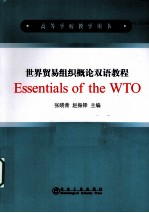
- 作 者:张晓青,赵振铎著
- 出 版 社:北京:冶金工业出版社
- 出版年份:2010
- ISBN:9787502453213
- 标注页数:118 页
- PDF页数:126 页
请阅读订购服务说明与试读!
订购服务说明
1、本站所有的书默认都是PDF格式,该格式图书只能阅读和打印,不能再次编辑。
2、除分上下册或者多册的情况下,一般PDF页数一定要大于标注页数才建议下单购买。【本资源126 ≥118页】
图书下载及付费说明
1、所有的电子图书为PDF格式,支持电脑、手机、平板等各类电子设备阅读;可以任意拷贝文件到不同的阅读设备里进行阅读。
2、电子图书在提交订单后一般半小时内处理完成,最晚48小时内处理完成。(非工作日购买会延迟)
3、所有的电子图书都是原书直接扫描方式制作而成。
Chapter 1 The Establishment and Operating System of the WTO 1
1.1 The Establishment of the WTO 1
1.1.1 The GATT years:from Havana to Marrakesh 1
1.1.2 The Uruguay Round 3
1.1.3 The post-Uruguay Round built-in agenda 6
1.2 The Status,Purpose,Objectives and Functions of the WTO 7
1.2.1 Status of the WTO 7
1.2.2 The purpose of the WTO 7
1.2.3 The objectives of the WTO 8
1.2.4 The functions of the WTO 8
1.2.5 Differences between GATT and WTO 8
1.3 Scope of the WTO 8
1.4 Structure of the WTO 9
1.4.1 The Ministerial Conference 9
1.4.2 The General Council in three guises 9
1.4.3 Councils for each broad area of trade,and more 9
1.4.4 Committees 10
1.4.5 Plurilateral Committee 10
1.4.6 The Secretariat and director-general 10
1.5 Decision-making of the WTO 12
1.5.1 Decisions taken by consensus 12
1.5.2 Levels of authority 12
1.6 Membership of the WTO 16
1.6.1 Original membership 16
1.6.2 Accession to the WTO 16
1.6.3 How to join the WTO:the accession process 16
1.6.4 Withdrawal from the WTO 17
1.7 Relationship with Other Main Organizations and Regionalism 17
1.7.1 Summary on other organizations 17
1.7.2 Relationship with regionalism 27
Questions 29
Notes 29
Chapter 2 Principles of the WTO 32
2.1 Trade without Discrimination 32
2.1.1 Most-favoured-nation(MFN) 32
2.1.2 National treatment:treating foreigners and locals equally 34
2.2 Freer Trade:Gradually,through Negotiation 35
2.2.1 Trade barriers 35
2.2.2 The result of negotiations 35
2.3 Predictability:through Binding and Transparency 36
2.3.1 Purpose of predictability 36
2.3.2 Predictability through binding 36
2.3.3 Predictability through transparency 36
2.4 Promoting Fair Competition 37
2.5 Encouraging Development and Economic Reform 37
2.5.1 Contribution to developing countries in the WTO 37
2.5.2 Commitment fulfilled by developing countries 37
2.5.3 Measures to encourage development and economic reform 38
Questions 38
Notes 38
Chapter 3 The Agreements of the WTO 41
3.1 Agreements for Trade in Goods 41
3.1.1 Tariffs:more bindings and closer to zero 41
3.1.2 Agriculture:fairer markets for farmers 42
3.1.3 Standards and safety 45
3.1.4 Textiles:back in the mainstream 47
3.1.5 Anti-dumping,subsidies,safeguards:contingencies,etc 49
3.1.6 Non-tariff barriers:red tape,etc 54
3.1.7 Plurilaterals:of minority interest 57
3.2 Agreement for Trade in Service 58
3.2.1 The background for GATS 58
3.2.2 Main content of GATS 59
3.2.3 General obligations and disciplines 59
3.2.4 The annexes:services are not all the same 61
3.3 Agreement for Trade-related Aspects of Intellectual Property Rights 62
3.3.1 Scope of intellectual property 62
3.3.2 International protection of intellectual property and TRIPS 65
3.3.3 Summary on TRIPS 66
Questions 69
Notes 69
Chapter 4 The Policy Review and Settling Dispute 76
4.1 Trade Policy Review 76
4.1.1 Ways to keep trade policies transparent 76
4.1.2 Trade Policy Review Body 77
4.2 Settling Dispute 78
4.2.1 Summary on dispute settlement mechanism 78
4.2.2 Scope of jurisdiction of DSM 81
4.2.3 WTO bodies involved in the dispute settlement process 81
Questions 85
Notes 85
Chapter 5 Developing Countries 86
5.1 Overview 86
5.1.1 In the agreements:more time,better terms 86
5.1.2 Legal assistance:a secretariat service 87
5.1.3 Least-developed countries:special focus 87
5.1.4 A"maison"in Geneva:being present is important,but not easy for all 88
5.2 Committees 88
5.2.1 Trade and Development Committee 88
5.2.2 Subcommittee on Least-Developed Countries 88
5.2.3 The Doha agenda committees 89
5.3 WTO Technical Cooperation 89
5.3.1 Mission,objective and subjects 89
5.3.2 Training,seminars and workshops 89
5.4 Some Issues Raised 90
5.4.1 Participation in the system:opportunities and concerns 90
5.4.2 Erosion of preferences 91
5.4.3 The ability to adapt:the supply-side 91
Questions 91
Notes 92
References 94
Appendix 95
Appendix 1 Current WTO Members 95
Appendix 2 Abbreviations 99
Appendix 3 Glossary 100
Appendix 4 Reading Materials 103
